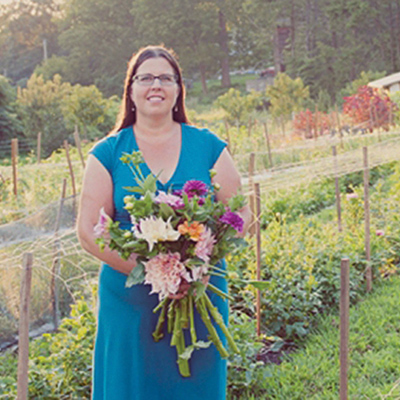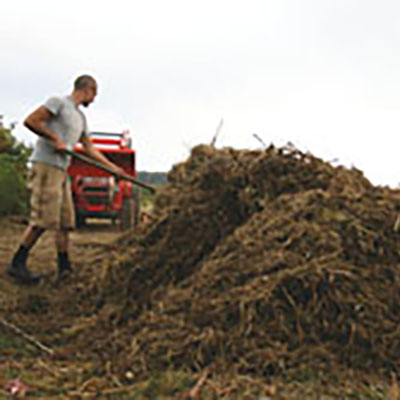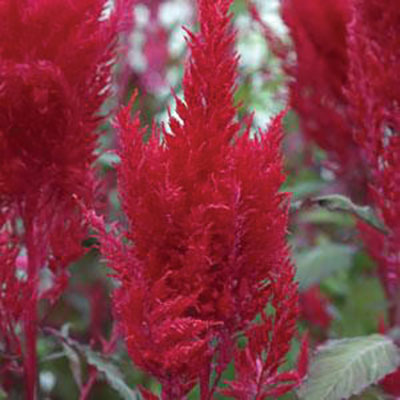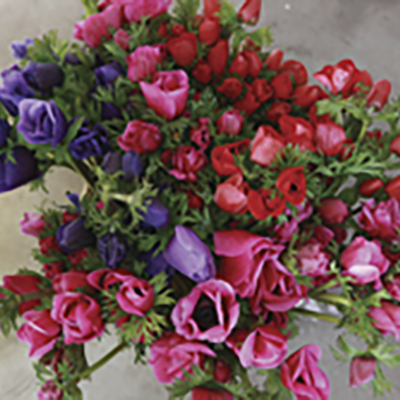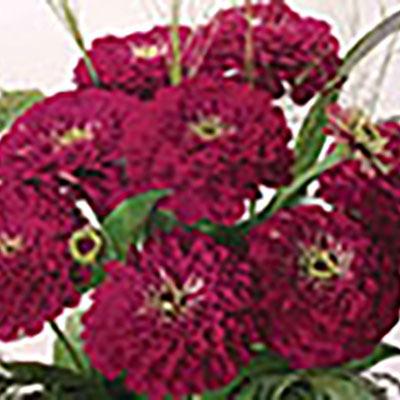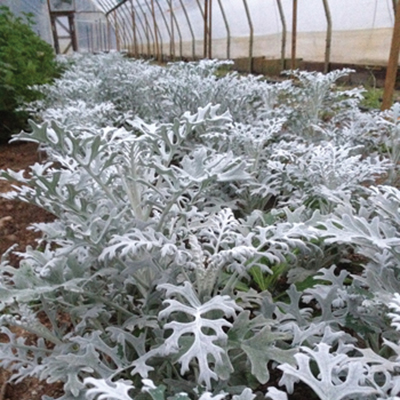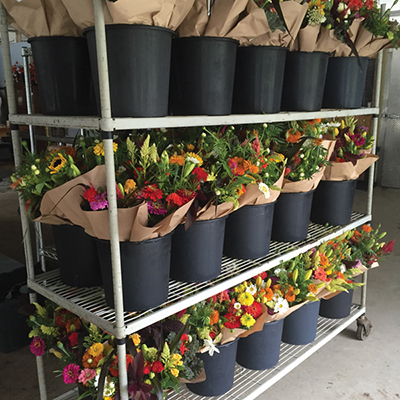Drying flowers may seem like a trend that went out of style in the 1980s, but they are making a comeback. Since you probably have some flowers already in your repertoire that will work for drying, why not use them to help extend your season once the frost has come?
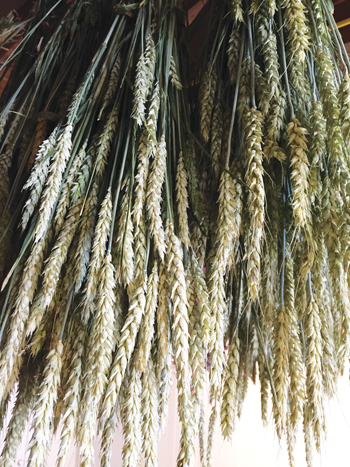 We start making dried flower bouquets and wreaths in September when people start decorating for fall, but we sell a majority of them toward the end of our farmers market season in late October into November. It is a good way to still be a part of people’s décor through the winter even when there isn’t a farmers market. When customers ask me how long they last, I usually tell them that I replace mine each year since they tend to get dusty. That increases perceived value, plus helps your sales the following year when customers realize they shouldn’t hold onto them indefinitely.
We start making dried flower bouquets and wreaths in September when people start decorating for fall, but we sell a majority of them toward the end of our farmers market season in late October into November. It is a good way to still be a part of people’s décor through the winter even when there isn’t a farmers market. When customers ask me how long they last, I usually tell them that I replace mine each year since they tend to get dusty. That increases perceived value, plus helps your sales the following year when customers realize they shouldn’t hold onto them indefinitely.
The best flowers for drying
Being busy enough throughout the summer, I needed things that are considered “everlasting,” meaning flowers that would air-dry when hung. There are more options if you want to deal with silica gel or other preservatives, but I wanted something quick and easy. Our dried flower adventure started with drying larkspur that was too bloomed out to sell fresh. Then we would pull anything dryable from any bouquets that came back from market, but now we also harvest things intentionally for drying. When hanging, we make sure that the bunch is small enough that the rubber band goes around it three times. As the flowers dry and shrink, this will ensure that the band still holds it together and bunches don’t fall apart as they are drying
Above: The author lets some winter cover crops, including wheat and rye, form heads so she can cut and dry them for fall use. Photos courtesy of Sunny Meadows Flower Farm.
Drying is a good use for the celosia that bloomed too short, or the oversupply of gomphrena that isn’t selling. Although it can help use up otherwise unsold product, it does require space for hanging, as well as the labor of picking and storing it. We first started by hanging flowers from the beams in the sunroom of our house, but that caused way too much pollen and celosia seed raining down upon us, so we started hanging them in the garage studio space instead. Cutting them short enough so they don’t hit you in the face when you walk underneath them became an issue, but now our processing area is in the barn, leaving the old garage studio space open for lots of drying! If you have a barn or a house with an attic available, some place hot and dry is best, and a dark location will ensure more color retention as well. When they are finished drying, we pla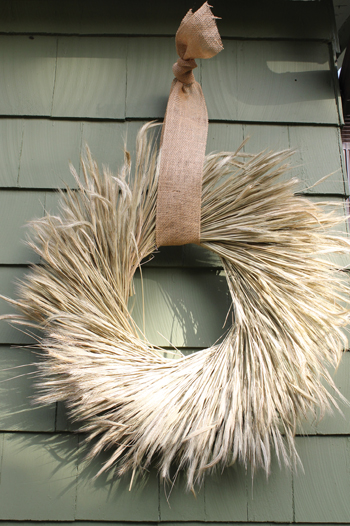 ce product into old flower boxes and put them up in the rafters of the garage so we can hang morefrom the beams.
ce product into old flower boxes and put them up in the rafters of the garage so we can hang morefrom the beams.
Lots of grasses can be dried — both the foliage and the plumes. We dry the plumes of miscanthus, which as they dry, poof out like frizzy hair or like someone who stuck their finger in a light socket. You have to harvest them young enough that they aren’t already dropping pollen; otherwise they will make a mess in transport and probably on your customers’ floors if they are jostled around.
Sorghums and grains are great for drying. We typically cover crop with rye and wheat for the winter, so I try to make sure there is a patch somewhere that is left unmowed so I can harvest it for drying. We have learned that if you grow a cover crop with vetch in the mix to leave a patch that is just the grain so you don’t have to fight the vetch when cutting it for drying. Sorghums are good fresh or dried, and we always make sure we have a lot of it for our fall dried arrangements. Our wreaths made entirely of broomcorn are popular in the fall, and broomcorn works well to fill dried arrangements. Other grass and grains that are good for drying: amaranth, sweet annie, barley, corn tassels, ruby silk, oats, sea oats, and all kinds of millets.
Right: A simple wreath made of dried rye sells for $45. The safflower wreath pictured on the next page sells for $55.
Celosia is a nice focal flower to use when making dried flower bouquets. Both the spike (plumosa or spicata) varieties, and the brain or crested varieties (cristata) work great for these purposes. So if you have a patch that blooms short or is sending out laterals that are too short for bouquets, cut them for drying and make a few more dollars from something you would have otherwise tilled in.
Larkspur is a useful dried flower to help get some nice color into your arrangements. We don’t take the time to strip the leaves off the stems for drying. After we go through and harvest the best stuff for fresh, someone follows behind and bunches the stems that are too bloomed out. Other flowers that are good for drying and will add color: Gomphrena, Statice, Salvia leucantha, and Yarrow ‘Cloth of Gold’. We like to use Safflower too, but have found the white doesn’t dry well, so we only grow the orange and yellow varieties. We haven’t yet been successful with getting Nigella established on our farm, but if you are so lucky, Nigella pods work for dried arrangements. Chinese lanterns are one of our favorites. These get all of their leaves cut off when harvested, and then we dry them right side up with the lanterns hanging over the edge of a bucket. That way they maintain their dangling shape instead of drying upside down.

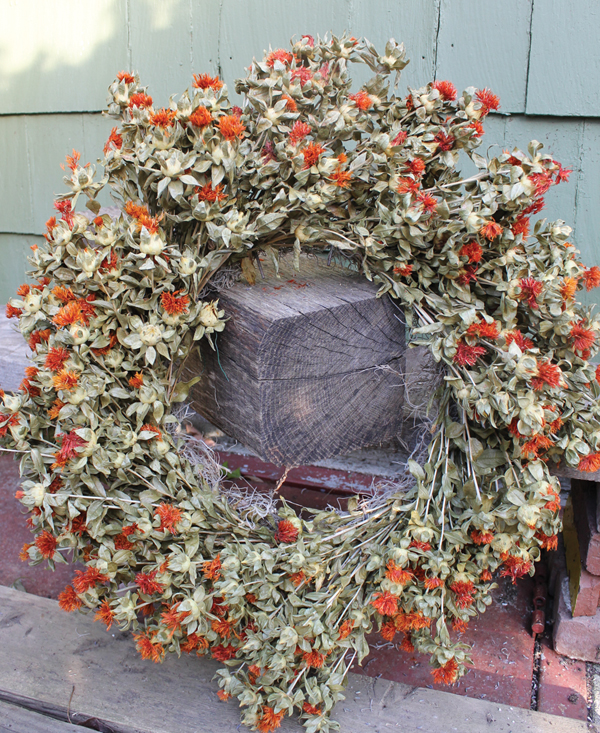 Hydrangeas can be dried once they have turned papery and have started to antique. If you harvest them before they are mature enough, you will see the middle of the flower head start to wilt when you hang it. We have more than 200 hydrangeas planted, but most of the blooms are sold fresh or used in wedding design. I look forward to having enough that we can also dry some. They would make a great addition to dried bouquets or to Christmas wreaths.
Hydrangeas can be dried once they have turned papery and have started to antique. If you harvest them before they are mature enough, you will see the middle of the flower head start to wilt when you hang it. We have more than 200 hydrangeas planted, but most of the blooms are sold fresh or used in wedding design. I look forward to having enough that we can also dry some. They would make a great addition to dried bouquets or to Christmas wreaths.
Herbs work well and it is good to have some foliage dried to help fill arrangements. We use: oregano with flowers, sage, lavender, rosemary, mountain mint, and any type of culinary mint. With the herbs, sometimes it takes a lot to make a little, so these are used sparingly when making wreaths. People seem to love the wreaths with lavender in them; they always sell first.
Chili peppers are a great dryable item, and we grow a ton of them. People love wreaths with peppers, whether they are entirely peppers or have peppers mixed in with other types of flowers. We like the Red Candles on Top (Gloeckner) or Nippon Taka (Johnny’s) varieties and have found that the red dry best. Orange work too, but no one wants to buy anything orange after Thanksgiving, whereas the red you can use all the way through Christmas. We plant about 75% red, and only 25% orange. We grow Black Pearl ornamental peppers for fresh cuts, but the chili pepper varieties dry best, as the round peppers tend to look a little shriveled when dried. All leaves are stripped off before drying and if we need them fast in the fall, we hang them in our house near the wood burning stove.
Remember that you want the flowers to look dried, not dead. We always have a few things that we test out that may get thrown out if they start to brown or didn’t hold their color. Since our spot to dry flowers in the garage is open air, if we have a wet or humid spell, sometimes things may rehydrate, which causes some browning. The Sylphid celosia is one flower that sometimes suffers in the drying process. It doesn’t look as good if you wait too long to pick it. If it is going to seed already, not only is it going to make a mess, it tends to look even more brown as it dries. You want any flowers to look good fresh going into the drying process, because drying isn’t going to make them look any better.
For a more complete list of everything that is dryable, check out the dried flower website by Cramer’s Posy Patch: www.cramersdried.com. They have a nice big barn with drying facility, so they definitely do it right. When I need something to add to my wreaths or didn’t dry enough, I order from them to supplement if needed.
Adding value to drieds
With our dried product, we make dried flower arrangements and dried flower wreaths. The arrangements use the taller dried product, and are about the same size as our regular fresh mixed bouquet. Since we use Kraft paper sleeves from A-Roo for our fresh bouquets, we first wrap the dried bouquets in colored tissue paper before putting in the Kraft paper sleeve to add a little brightness to the bouquet. We don’t want the brown paper accentuating anything to make it look browner, so the extra tissue paper layer helps act as a color buffer. Our standard market bouquet is $13, but we sell the dried for $15 to compensate for the extra labor involved.
The fall wreath idea for us started with grapevine/bittersweet wreaths we used to do with our farming mentor in his old, overgrown orchard. It took a long time to twist the vines around to make the frames, so we knew there had to be a better way. For quicker dried flower wreaths, we started using the same wreath machine we use for our Christmas wreaths. We got wreath rings with smaller clamps, and we put some moss down on the base to help hold all the stems in place. The machine and supplies are from Mitchell Wreath Rings, www.mitchellwreathrings.com; 800-967-7464.
When it comes time for wreath making, the team takes all the dried product down from the rafters. They start making little mini bunches, finishing them with a twist of floral wire around them. With the wreath rings, there is a clamp every inch, so the bunches don’t need to be very long. I take the first bunch and start in the wreath machine, then turn it to the next clamp, always covering the stems of the previous bunch. The last bunch is always the most difficult to wedge in there. You can use floral wire to twist around the frame if you need to add to any spots, or if there is a bunch that is having problems staying in the clamp.
We still use curly willow or grapevine as a base for some wreaths, but most of them are made on the metal wreath ring. Our wreaths sell at market from $25-45 depending on the size and fullness. We had a year when we were selling them to florists from $15-30, but we didn’t last year because we couldn’t keep up with our own demand at the farmers markets. We display them at market hanging on a piece of lattice. Floral wire is a great tool for all hanging purposes, and it’s stronger than you think.
It may seem like extra work during the busy part of the season, but hanging flowers to dry helps extend the season in the fall and even into winter.
Gretel Adams is the co-owner of Sunny Meadows Flower Farm in Columbus, Ohio.
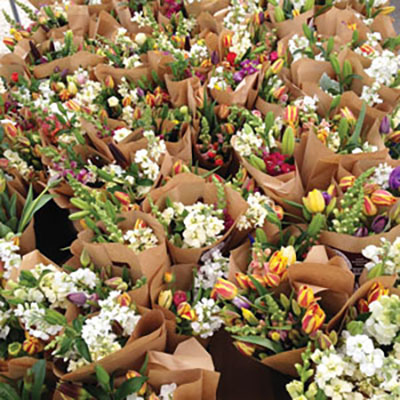

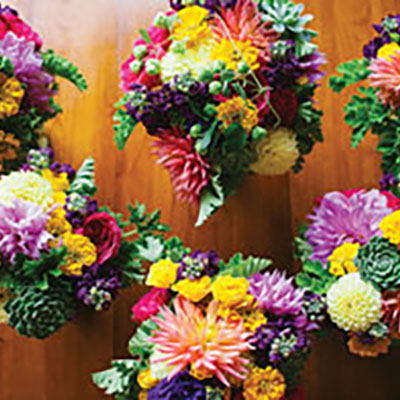
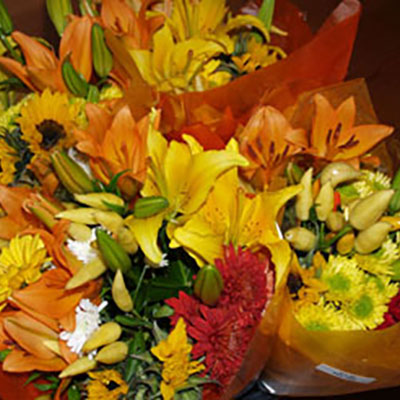
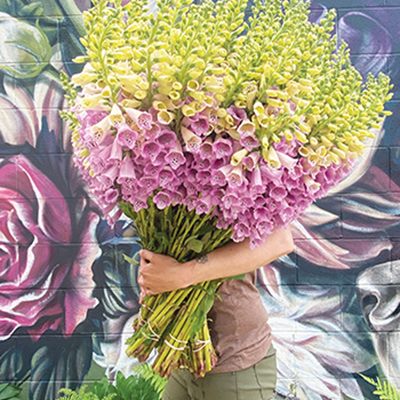



 I have been following the flower farming adventures of Pamela and Frank Arnosky, owners of Texas Specialty Cut Flowers, from the start. Their wonderful monthly column here in Growing For Market spanned more than 15 years and eventually became two fabulous books, We’re Gonna Be Rich (out of print) and Local Color (still available from GFM). When I got wind that the ASCFG was hosting one of their four conferences at the Arnoskys’ farm this winter, I flipped a gasket. Visiting their famous operation has long been a dream so with a little nudging from Lynn, my husband Chris and I hopped a plane and ventured deep into Texas hill country to learn the secrets of successful flower farming from two of the finest masters in the biz!
I have been following the flower farming adventures of Pamela and Frank Arnosky, owners of Texas Specialty Cut Flowers, from the start. Their wonderful monthly column here in Growing For Market spanned more than 15 years and eventually became two fabulous books, We’re Gonna Be Rich (out of print) and Local Color (still available from GFM). When I got wind that the ASCFG was hosting one of their four conferences at the Arnoskys’ farm this winter, I flipped a gasket. Visiting their famous operation has long been a dream so with a little nudging from Lynn, my husband Chris and I hopped a plane and ventured deep into Texas hill country to learn the secrets of successful flower farming from two of the finest masters in the biz!